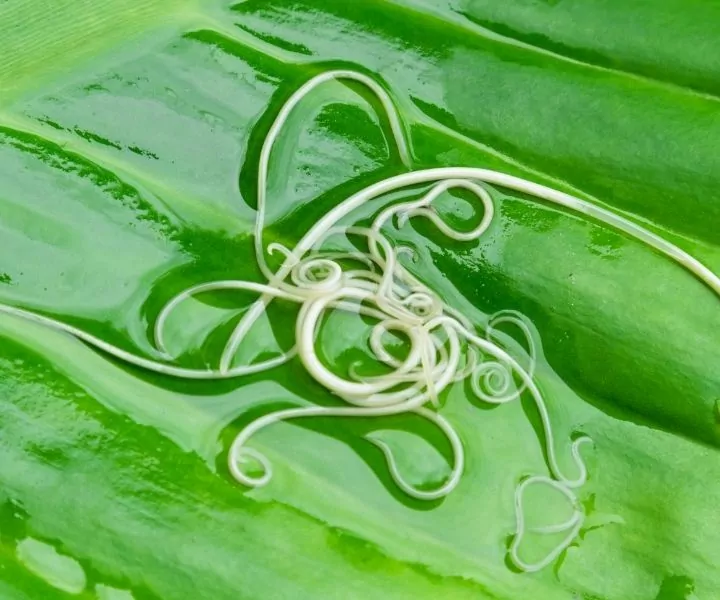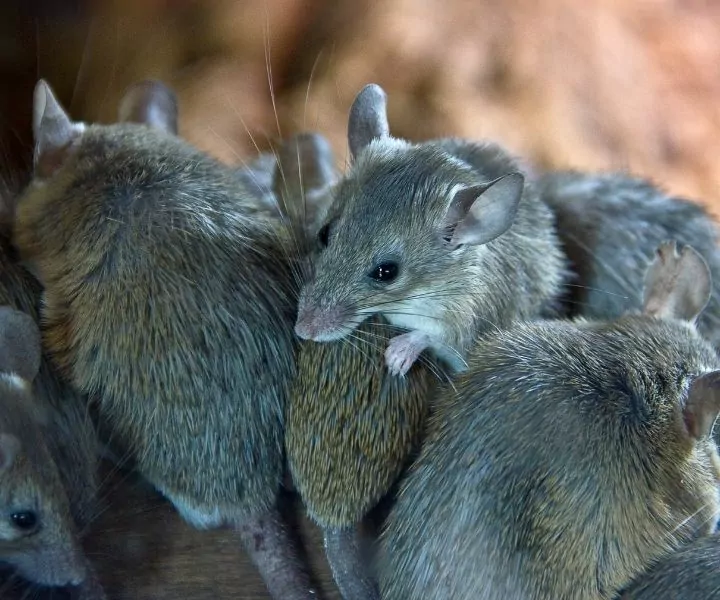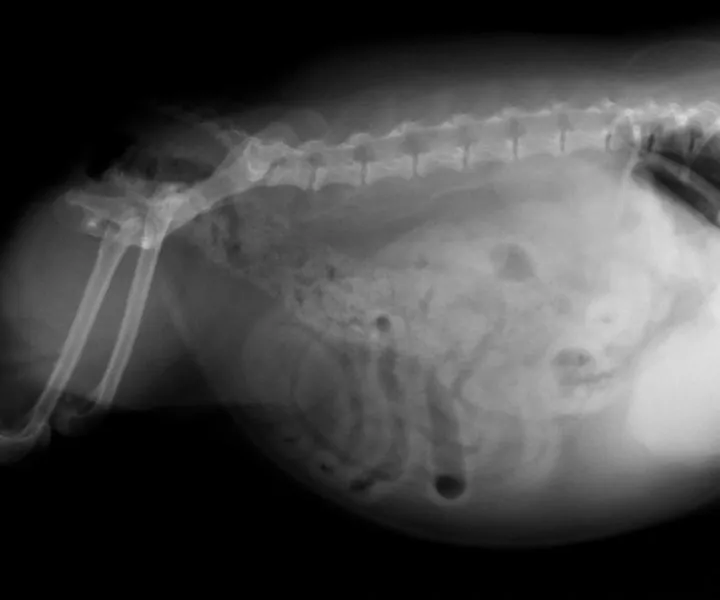How Do Dogs Get Roundworms?
Roundworms in Dogs are a common form of the parasite in our canine companions. They can be especially dangerous in puppies, but adult dogs and even humans can become infected.

There are a few common ways dogs get worms; these are described below:
Across the placenta (transplacental route)
When puppies are in their mother’s uterus, they can become infected with roundworms. This occurs when mother dogs have encysted larvae in their tissues that become activated by the pregnancy and emerge from their cysts.
These larvae then travel through the blood into the umbilical vein and into the puppies’ liver and lungs. When the puppy is born, the lifecycle of the larvae continues, and adult worms develop in the intestines. This is the primary route of infection.
Through the milk (transmammary route)
When a puppy is born and suckles from its mother, encysted larvae in the mother’s muscles and organs can travel through to the milk and become ingested by the puppy. The larvae can then complete their life cycle and become adult roundworms. This route of infection is less common.
Ingesting roundworm eggs
When adult dogs ingest eggs that can infect the dog with roundworms, the larvae then hatch and develop into adult worms. Dogs most commonly ingest worms by eating soil infested with eggs from another infected animal’s feces. Dogs can also become infected by eating mice or other small animals that are infected.

What Are Canine Roundworms And What Do They Look Like?
Canine Roundworms are, as they sound, a giant, round intestinal parasite that lives inside dogs. They are often pale grey or white-colored and can be several inches long (up to seven inches).
Roundworms are one type of common intestinal parasite. Other types include hookworms, whipworms, tapeworms, and heartworms. Infection with roundworms can be severe and sometimes fatal, especially in untreated puppies. Roundworms can also affect humans.
Scientifically they are classed as ascaridoid nematodes. The two most common species are Toxocara canis (T. canis) and Toxascaris leonina. T. Canis is the species that usually infects puppies and can also be passed to people.
Signs and Symptoms of Roundworms in Dogs
As mentioned previously, puppies and adult dogs can become infected with roundworms. The infection is most serious in puppies as their immune system is weaker, meaning a larger, more severe infection can occur.
The initial stages of infection may not show obvious signs. Typically, when the larvae develop into adult worms, they begin feeding on the nutrients that the puppy ingests. This is the stage where the infection becomes most apparent.
Common signs you may notice if your puppy is infected with roundworms includes:
- Poor growth
- Underweight
- Dull coat
- Rounded abdomen
- Vomiting and diarrhea, you may see worms in dog poop.
- Coughing
- Stomach pain

Other signs that your veterinarian might see include:
- Eggs and larvae can be seen in the feces under a microscope
- Fluid in the abdomen
- Fatty liver
- Low protein in blood work
- Granuloma on kidneys
Adult dogs may show the signs above but may also show no signs of infection.
The Life Cycle of Roundworms in Adult Dogs
In an infected dog, adult female and male roundworms mate. When the female is gravid, it will produce thousands of eggs every day. These are released into the small intestine and shed into the feces, out into the environment.
Under the correct environment (temperature, humidity, light), the eggs begin to develop into infective larvae (L3), which are still contained inside the egg. This process can take between two to four weeks.
The larvae can then be ingested when a suitable host comes along and eats them. When in the intestines of the host, the egg hatches, releasing the L3 larvae. These larvae migrate across the intestinal wall and into the bloodstream; they continue to travel into the liver and lungs of infected animals. In the lungs, the larvae burst into the air sacs (alveoli).
Once in the lungs, the larvae can either travel up into the windpipe of dogs (trachea) and be coughed and swallowed back into the intestines (tracheal migration), or they can go back into the bloodstream from the air sacs and travel to muscles and organs (somatic migration).
The larvae that are swallowed back into the intestines continue to develop into adult roundworms and will then breed, repeating the cycle.
Larvae that travel to muscles and organs cease development and instead become encysted. It is the encysted larvae that can infect puppies in utero or suckling newborns. A trigger occurs when a pregnant dog stimulates the encysted larvae to migrate and continue the infection.
The Prevention and Treatment of Roundworms in Canines
The good news is that roundworms are easily treated and prevented. This section will explain how to get rid of roundworms in dogs and how to avoid reinfection.
Treatment
Various dewormers (anthelmintics) are effective at killing roundworms. Affected puppies and dogs should be treated repeatedly at two to three-week intervals to kill any migrating larvae.
Dewormers can be bought from pet stores and veterinary clinics. It is essential to buy a product that effectively kills all worms (“all wormers”), as some may only target tapeworms. Heartworm medicine will often kill roundworms but check with your veterinarian as to what will work best in your dog’s specific use case.
The prognosis is good for puppies and dogs that are treated unless infection severely stunts growth, in which case, the anticipated full size may never be attained. In puppies that aren’t treated and have a severe infection, roundworms can be fatal. There are no effective natural remedies for roundworms in dogs.
Prevention
Preventing infection in puppies
Pregnant female dogs should be regularly treated with dewormers from late gestation until puppies are weaned. This will help prevent transplacental and transmammary infection in puppies and prevent infection in the mother.
Good hygiene is essential, any feces should be cleaned, and any soiled bedding should be washed on a hot laundry cycle.
Newborn puppies can be treated with dewormers that are safe, which can be repeated at two, four, six, and eight weeks of age. This can then be continued monthly until the puppies are six months old.
Preventing infection in adult dogs
It is crucial to treat adult dogs regularly to prevent larvae from developing into adults and breeding, releasing eggs. With regular treatment, larvae will be killed before they become adults.
Worming every three months is most commonly recommended, but if a dog is in a significantly contaminated environment (e.g., a shelter) or their immune system is compromised (e.g., having chemotherapy), more regular deworming may be necessary.
Some heartworm preventatives may be effective against roundworms. Ask your veterinarian if you need to treat them if they are already on a heartworm preventive regime.

Roundworm eggs are highly resistant to common disinfectants such as bleach, and changes in the environment (e.g., temperature and sunlight) and can survive for years. The eggs are also very sticky, which makes them difficult to remove from surfaces, including concrete.
This means that dogs and humans can become infected from ingesting the eggs long after the infected dog has gone. Regular treatment of dogs is, therefore, the mainstay in the prevention of roundworms.
Can Humans Get Roundworms?
Humans are not the natural host for canine roundworms. This means that when a human is infected, the larvae do not develop into adults and breed. Instead, the eggs ingested will hatch, releasing the larvae. These usually do not cause any significant problems.
In some rare but severe cases, the larvae can begin migrating through the infected human organs and tissues. This is called larva migrans. When the larvae travel through tissues, this is called visceral larval migrans and can be of varying significance depending on the tissue/organ affected and how many larvae migrate.
Larvae can also migrate through other organs, such as the eye (ocular larva migrans); this can be very serious and potentially lead to blindness. Humans typically become infected by ingesting eggs either in the soil from an infected dog that passed feces in the area or eating food with hands contaminated with dog feces. Typically, children are most at risk, and good hand hygiene is essential.
If you are worried you or your child could be affected by larval migrans, contact your doctor.
Parting Words
Roundworms are intestinal parasites that can be reasonably innocuous but, in certain circumstances, can be very serious. Young puppies are most at risk when they are in the womb or newborns suckling from their mother, but adult dogs can also become infected.
Humans, in particular children, can become affected by roundworms when the roundworm eggs are ingested. As such good hand hygiene and treating family dogs is essential.

The best thing to do is regularly treat your dog, especially if they are a puppy or pregnant, and seek veterinary advice if required. With appropriate, regular deworming, roundworms should not cause a problem for your pet.
